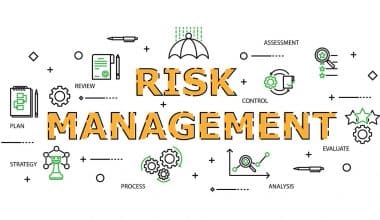Risk management is the process of understanding, anticipating, and managing risk. In other words, it’s about making sure that your business is prepared for any surprises or emergencies. As you can imagine, no one wants to run their business in a way that leaves them vulnerable to any particular risks. However, it’s also not possible to prepare for every risk that’s out there. In this post, we’ll look at some of the best risk management tools, such as healthcare, third-party, and vendor risk management tools, as well as how they can help your company reduce its vulnerability to various types of risks.
What Are Risk Management Tools and Techniques?
Risk management tools and techniques help businesses identify, assess, and manage risk. By identifying risks early, businesses can take steps to avoid or mitigate them. Common risk management tools and techniques include risk registers, business impact analyses, and contingency plans.
Risk Management Tools in Healthcare
In the field of healthcare, risk management is a critical process that helps protect patients, staff, and the organization as a whole from potential harm. Risk management is possible with many different tools and methods, but not all of them work as well. In this section, we’ll take a look at some of the most popular risk management tools in healthcare and see how they can help keep your organization safe.
#1. A Risk Register
A risk register is a document that lists all of the potential risks that an organization faces. This tool can be used to track and monitor risks over time, and to identify trends.
#2. SWOT Analysis
This tool not only helps organizations identify their strengths, weaknesses, opportunities, and threats but is also used to develop strategies to reduce the impact of risks.
#3. Legal System
The legal system is used to identify risks, set standards for how risks should be managed, and hold people accountable if they don’t manage risks properly.
The legal system can also provide compensation for people who are harmed by risks that were not properly managed. This compensation can help to cover medical expenses, lost wages, and other damages.
#4. Risk Priority Number (RPN)
The RPN is a numerical rating that is used to assess the severity of a risk. It is calculated by multiplying the probability of an event occurring, the severity of the event, and the detection rating.
Organizations can use the RPN to prioritize risks and determine which risks need to be addressed first. By addressing the most severe risks first, organizations can minimize the impact of potential events.
#5. Cost Benefit Analysis (CBA)
This tool assesses the costs and benefits of different actions to determine which action is most beneficial for the organization.
The CBA can be used to compare different risk mitigation strategies and choose the strategy that will provide the most benefit for the organization. This tool can also be used to assess the financial impact of potential events.
#6. Electronic Health Record (EHR)
EHRs can help to track patient data and also identify potential risks. However, they can also be expensive to implement and maintain.
#7. Clinical Decision Support Systems (CDSSs)
CDSSs help clinicians make better decisions by providing them with evidence-based guidelines. However, CDSSs can be complex to implement and use.
#8. Data Mining
Data mining involves analyzing large data sets to identify patterns and trends. This information can then be used to develop strategies for reducing risk. However, data mining can be time-consuming and expensive.
#9. Compliance Reporting
Compliance reporting helps healthcare organizations track and report on compliance-related issues. This information can be used to identify patterns and trends and to develop corrective action plans.
Compliance reporting can be done internally by healthcare organizations, or it can be outsourced to third-party providers.
#10. Incident Reporting
Incident reporting helps healthcare organizations track and report on incidents that occur within their organization. This information is used to identify patterns and trends and to develop corrective action plans.
Incident reporting can be done internally by healthcare organizations, or it can be outsourced to third-party providers. There are several different incident reporting software programs available on the market.
Healthcare providers would benefit from making use of the aforementioned risk management tools.
Enterprise Risk Management Tools
There are a variety of enterprise risk management tools available to help businesses manage risk. But which tool is right for your business? The following is a quick overview of some of the most popular options:
#1. Risk management software
This type of software helps businesses identify, assess, and track risks. It can also help businesses develop risk mitigation plans.
#2. Business continuity planning software
This software helps businesses plan for and manage disruptions. It can also help businesses identify potential risks and develop plans to keep operations running in the event of an incident.
#3. Crisis management software
This software helps businesses plan for and respond to crises. It can help businesses identify potential risks, develop response plans, and coordinate resources during an incident.
#4. Insurance Programs
Insurance can help businesses transfer the financial risk of an incident to an insurance company. By buying an insurance policy, you can protect yourself from risks like damage to your property, the cost of defending yourself in court, and the loss of business.
#5. Risk Financing Programs
Risk financing programs can help businesses finance the costs of an incident. Programs can include loans, lines of credit, and government assistance programs.
#6. Employee Training Programs
Employee training programs can help businesses reduce the risk of employee-related incidents.
What Is the Best Risk Management Tool?
There is no one-size-fits-all answer to this question, as the best risk management tool for a given organization will depend on its specific needs and circumstances. However, some common risk management tools include impact analysis, risk registers, and business continuity plans. Whatever tool or combination of tools an organization chooses to use, they must be regularly reviewed and updated to ensure that they remain effective.
Check Out: 10 BEST FLEET MANAGEMENT SOFTWARE IN 2022
What Are the Four Risk Control Techniques?
There are four main risks control techniques:
- Risk avoidance
- Risk reduction
- Risk transfer
- Risk-retention
Each technique has its advantages and disadvantages, so it’s important to choose the right one for your organization. Let’s take a closer look at the following technique:
#1. Risk Avoidance
Avoiding risk altogether is often the best strategy, but it’s not always possible. For example, you can’t avoid the risk of losing money if you invest in stocks. However, you can avoid the risk of losing money in a bad investment by doing your research first.
#2. Risk Reduction
Reducing risk means taking steps to lessen the chance of something bad happening. For instance, you can reduce the risk of car accidents by obeying traffic laws and driving defensively.
#3. Risk Transfer
Transferring risk means shifting the responsibility for dealing with a potential loss from one party to another. For example, you can transfer the risk of car accidents to your insurance company by buying car insurance.
#4. Risk Retention
Retaining risk means accepting the possibility of a loss and taking steps to minimize it.
Third-Party Risk Management Tools
As a business owner, you know that working with third parties can be a risky proposition. As a result, you can mitigate some of that risk by using third-party risk management tools to help you screen and monitor your vendors.
There are several different third-party risk management tools available, each with its own strengths and weaknesses. Some are better for screening vendors before you enter into a contract, while others are more useful for ongoing monitoring. And still others are designed specifically for certain industries or types of risks.
Choosing the right tool(s) for your business will depend on several factors, and this includes the size and complexity of your organization, the nature of your relationships with third parties, and the types of risks you are most concerned about.
The following is a brief overview of some of the most popular third-party risk management tools:
#1. Vendor Management Systems
A vendor management system (VMS) is a software application that helps businesses manage their relationships with vendors. It can be used to track and store data on vendors, automate vendor onboarding and due diligence processes, and create and manage contracts. VMSes vary in features and functionality, so it’s important to choose one that meets the specific needs.
#2. Risk Assessment Tools
These tools help businesses identify and assess the risks associated with working with third parties.
#3. Contract Management Tools
These tools help businesses manage their contracts with third parties and also ensure that all parties are meeting their obligations.
#4. Monitoring and Reporting Tools
These tools help businesses monitor the performance of their third parties and report any issues or concerns to the appropriate authorities.
See Also: WORKFORCE MANAGEMENT SOFTWARE: How It Works [+Top 10 Picks]
#5. Training and Awareness Programs
This program help businesses train their employees on how to identify and mitigate third-party risks.
#6. Insurance Programs
These programs can provide financial protection if a third party causes damage or loss to a business.
Vendor Risk Management Tools
There are a variety of vendor risk management tools available to help organizations manage and mitigate the risks associated with third-party vendors.
These tools can be used to assess vendor performance, track vendor compliance, and identify and address potential risks.
Organizations should select vendor risk management tools that best fit their needs and objectives. Some common vendor risk management tools include:
#1. Vendor Performance Tracking Tools
These tools help organizations track and monitor vendor performance against key metrics. Furthermore, it is used to identify trends and potential areas of concern.
#2. Vendor Compliance Tracking Tools
These tools help organizations track and monitor vendor compliance with internal policies and procedures. This information can be used to identify areas of non-compliance and take corrective action.
#3. Vendor Risk Assessment Tools:
These tools not only help organizations identify and assess potential risks associated with third-party vendors but can also be used to develop mitigation strategies and improve vendor selection processes.
#4. Vendor Performance Scorecard
This is a way to track and monitor how well your vendors are performing. You can rate them on different criteria, such as quality, delivery, customer service, etc. This helps you to get a sense of which vendors are performing well and which ones might be causing problems.
#5. Contract Management System
This helps you to keep track of your contracts with vendors and makes it easy to see when they’re due for renewal. It can also help you to track payments and performance clause adherence.
#6. Insurance
You can get insurance that covers you in case a vendor doesn’t meet its obligations or causes damages. This can give you some financial protection in case of vendor problems.
#7. Qualys Policy Compliance
This tool helps organizations assess and manage vendor compliance with security policies. It includes a customizable policy library and provides real-time visibility into compliance status.
#8. SecurityScorecard
This tool provides ratings and insights for vendors, based on their security posture. It offers a free version as well as a paid version with more features.
#9. Gartner Vendor Risk Management Framework
This framework guides assessing and managing vendor risk. It includes a vendor questionnaire and assessment checklist.
#10. VendorInsight
This tool helps organizations manage vendor risk by providing data-driven analysis and recommendations. It offers a free trial as well as a paid subscription.
#11. VRM360
This tool helps organizations automate the vendor risk management process, from assessment to remediation. It offers a free trial as well as a paid subscription.
Risk Management Tools in Insurance
There are a variety of risk management tools available to insurance companies. These tools can be used to help identify, assess, and manage risks. Some of the most common risk management tools used in the insurance industry include:
#1. Risk Maps
Risk maps are used to visually depict risks. They can be used to identify areas of high risk, as well as potential sources of future risks.
#2. Risk Registers
A risk register is a list of all the identified risks for a company or project. It can be used to track and monitor risks over time.
#3. Risk Analysis
Risk analysis is a process of identifying and assessing risks. It can involve quantitative or qualitative methods.
#4. Risk Mitigation
Risk mitigation is the implementation of measures to reduce or eliminate risks. This can include insurance, hedging, or other strategies.
Check Out: INVENTORY MANAGEMENT SOFTWARE: Top 9 Options
#5. Risk Management Plans
A risk management plan is a document that outlines how a company will deal with risks. It should include identification, assessment, mitigation, and monitoring procedures.
#6. Risk Analysis
Risk analysis helps insurers identify potential risks and quantify their impact. It is often used in conjunction with other tools, such as insurance policy reviews, to provide a comprehensive picture of an insurer’s risks.
#7. Risk Mitigation
Risk mitigation helps insurers reduce the impact of risks by implementing controls or taking action to minimize the loss exposure. For example, an insurer might purchase insurance to protect against fire damage, or it might take steps to improve its fire safety procedures.
#8 Risk Transfer
Risk transfer involves shifting the financial burden of a loss from one party to another through contracts or insurance policies. For example, an insurer might require a business to purchase insurance coverage for certain types of losses, or it might agree to indemnify the business for certain types of losses.
Conclusion
In this piece, we discussed the top risk management solutions, such as healthcare, third-party, and vendor risk management tools, and how they may help your business lessen its exposure to various risks. I really do hope this was informative.
Risk Management Tools FAQs
What tool can be used to identify potential project risks?
SWOT, or strengths, weaknesses, opportunities, and threats, is a tool to help with identifying risks.
What are the tools used in risk assessment?
The four common risk assessment tools are risk matrix, decision tree, failure modes and effects analysis (FMEA), and bowtie model.
At what project stage should risk management processes be conducted?
You should create your risk management plan during the project planning phase.
References
- en.m.wikipedia.org – Risk management tools
- www.researchgate.net – Risk Management Tools in Healthcare
- getindemnity.co.uk – Risk Management Process and Insurance
- www.inflectra.com – The Top 10 Enterprise Risk Management Tools
- www.esecurityplanet.com – Best Third-Party Risk Management (TPRM) Tools for 2022
- www.trustradius.com – Vendor Risk Management Software
- 33 Best Event Management Software and Tools In 2022
- Top 11 Business Intelligence Software and Tools In 2022
- Project Management Reporting: Examples, Software & Tools
- MANPOWER MANAGEMENT: 11+ Efficient Manpower Management Tools
- Energy Management Systems: Best Systems In 2022
- VULNERABILITY MANAGEMENT TOOLS: Top 10 Best Vulnerability Management tools
- PERFORMANCE MANAGEMENT TOOLS: Definitions, Examples, And Best Tools






